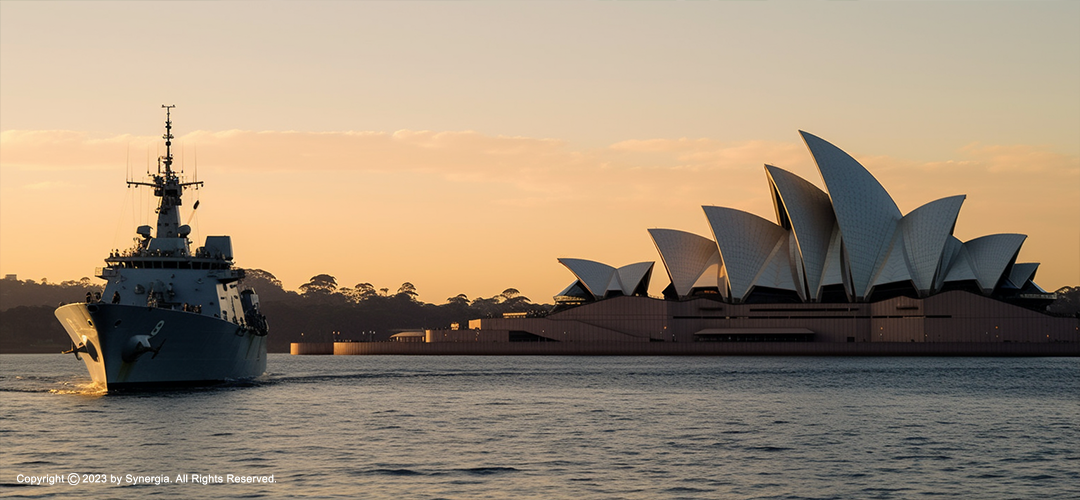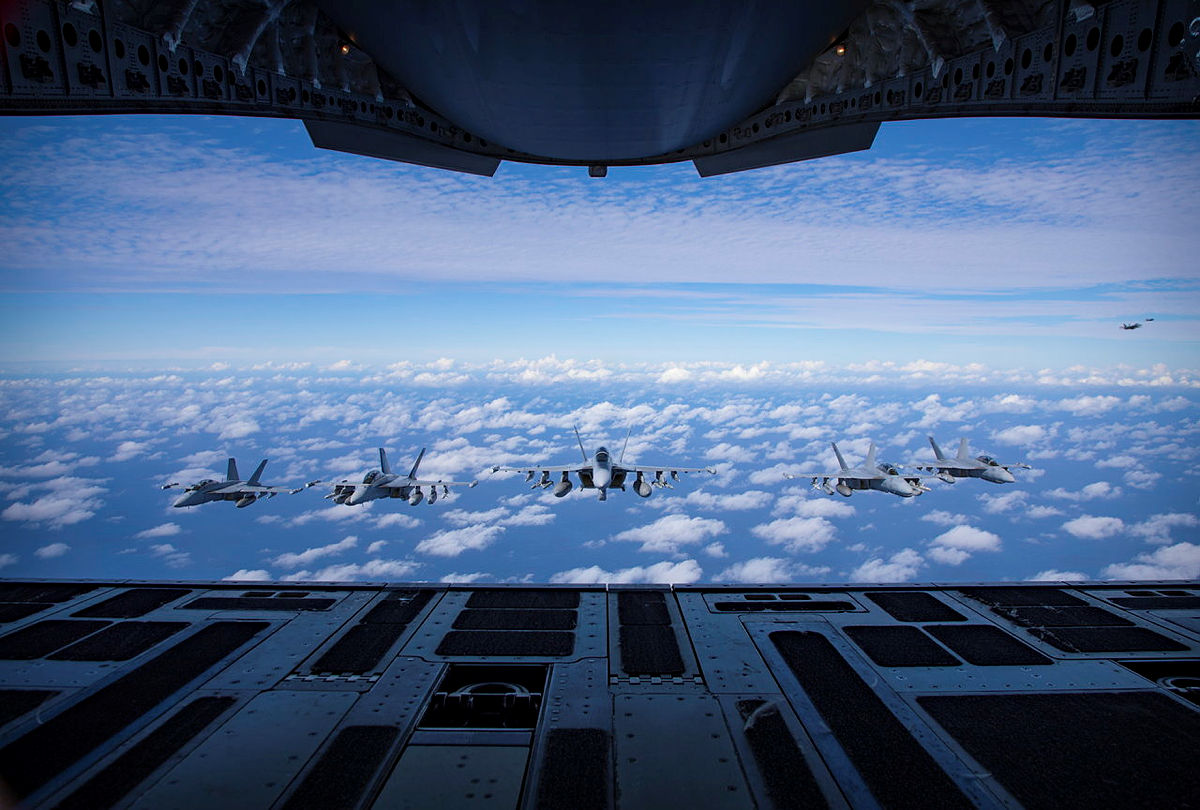Shifting Antipodean Geopolitical Stance
April 29, 2023 | Expert Insights

Australia, situated in the southern part of the wider Indo-Pacific region, has been a geopolitical outlier for most of its history. This is largely due to the distance of the Australian continent from the world's major power centres.
Till the 1940s, Australia never tried to align itself with Asia, considering itself more as a part of the U.S. and UK Atlantic alliance. To keep faith with its distant allies, it never shrunk from participating in their wars - from World War I through the struggle against Nazi Germany and Imperial Japan in WW II and more recently in Korea, Vietnam, Kuwait, Iraq and Afghanistan.
However, the geopolitical balance is shifting, and Canberra, once again, after the 1942 nightmare of an imminent Japanese invasion, feels apprehensive of the inexorable rise of yet another great Asian power in the Indo-Pacific.
Australia and India have a history of love-hate relationships; Canberra was one of the most vocal critics of India going nuclear in 1988 and imposed a slew of sanctions. However, geopolitical compulsions make it imperative for both democracies (and cricket lovers) to draw closure. Therefore, how Australia plans to secure its sovereign territory is of great interest to India.
Background
Historically, Australia’s national security was closely tied with that of the wider British Empire. Wherever British colonial troops fought, Australian soldiers contributed along with their New Zealander and Canadian counterparts. These war zones were normally far away from the Australian mainland, and they had no geo-strategic significance for Australia as such. Just the imperial connections made Australia a part of these wars. These wars also helped to shape the Australian national identity. This was especially the case during the First World War. During the Gallipoli campaign against the Ottoman Empire, Australian troops made a significant contribution along with other Allied forces. ANZAC Day is still an emotional day of remembrance, observed solemnly by Australians every year wherever they may be located.
Only when the Imperial Japanese forces were rampaging through the Pacific did the Australian mainland face the threat of invasion for the first and last time. However, by this time, Imperial Japan had reached the outer limit of its logistic reach and could not sustain a further expansion into the huge Australian continent,
During the Cold War, Australia felt secure under the security shield of the U.S. as Russia was never a major maritime power and had little capability in the Indo-Pacific.
The United States gradually replaced the United Kingdom as Australia's main security partner. When Southeast Asia was in danger of falling under Communism, Australia's strategic location proved important. Australian troops contributed to the U.S.-led efforts in the Korean and Vietnam Wars. These wars were much more relevant for Australia as they were much closer to its territory than earlier ones.
But this was not just a one-way street with only Australia supporting the U.S. military efforts. Instead, Australia itself was incorporated into the emerging global U.S. security architecture. It became a part of the Australia, New Zealand and United States (ANZUS) treaty. This was a military alliance between all these Anglophone powers to combat Communist encroachment in the Pacific Ocean. This arrangement has remained strong right up until the present day. There is also intelligence sharing between Australia and the United States under the Five Eyes framework, which consists of the U.S., UK, Canada, Australia and New Zealand. The AUKUS deal will enable Australia to operate nuclear-powered (but conventionally armed) submarines in the Indo-Pacific, a capability that will enhance its naval reach and firepower many times over.
Another major strategic factor that compels Australia to seek an Anglo-Saxon alliance is its low population base which inhibits it from mustering large armies. While the small, well equipped and very professional Australian military has intervened regionally in the Solomon Islands, in East Timor and sent troops to conduct elections in Papua New Guinea (PNG), Australia depends on outside powers for its security. It may be hard-pressed to fight back a large invading force landing in some remote uninhabited part of this vast continent. Australia's defence lies in destroying any sea-borne invasion while it is on the high seas before it touches its landing beaches.
One startling thing that stands out is that Australia has not had a close military relationship with a major Asian power in its modern history until recently. This was mostly due to cultural reasons, as Australians preferred to work with Anglophone countries with a similar culture. Indonesia is the closest Asian country to Australia. The first security agreement between Australia and Indonesia was signed in 1995, which proved short-lived. Tensions between Indonesia and Australia began to rise over the latter's support for the independence of East Timor from Indonesia. Soon this agreement was dissolved. In the case of other Asian powers, Australia engaged with Japan through its partnership with the United States. At the same time, India was considered too far off and, therefore, not relevant to Australia’s national security.
From the mid-1970s until the first decade of the 21st century, the waters surrounding Australia were geo-strategically speaking calm. This was the period of the “peaceful rise of China”. China and Australia developed a close relationship in the economic arena. Chinese students came in droves to Australia for educational purposes. Australian businesses began investing heavily in the booming Chinese economy. Uncomfortable issues like human rights in China were put to the side. But this bonhomie could not last forever. With the emergence of wolf-warrior Chinese diplomacy in the second decade of the 21st century, things began to change. Australia could no longer rely on Beijing’s goodwill anymore. So, it had no other option but to look towards emerging other Asian giants like India. The Australian security interaction with India has been both bilateral and multi-lateral. In the latter case, the Quad has played an especially important role.

Analysis
The recent military review by the Australian government is not just a routine bureaucratic check-up of the state of national defence.
Rather, this is a total restructuring of Australia's foreign policy. The Australian government no longer wants to be a middle power dependent on outside forces for its security.
Instead, it wants to be an independent power charting its security course. The military relationship with the United States cannot be changed in a single day. Australia still needs the technological expertise of the giants in the Western bloc, and the AUKUS nuclear submarine deal underlines this fact. At the same time, Australia is trying to reach out to its neighbourhood more meaningfully.
India is turning out to be the obvious choice for Australia in this changing geopolitical environment. The two countries have much in common. Both are former British colonies, and the English language is a common bond for shared understanding.
Australia is a preferred destination for Indians to immigrate for various reasons. Since it is less populated than the United States, visas are more easily available. There is a great demand for Indians in Australia. Indians come to Australia both for study and work purposes. The Indian workforce contributes significantly to the Australian economy. So, the people-to-people connections between the two countries are already well established.
On top of this, both India and Australia are thriving democracies. They both believe in a free and open Indo-Pacific region where all countries can navigate their vessels freely. This is directly against the Chinese vision of the region where Beijing decides who is allowed into which part of this region and who is not. Australia does not face a direct territorial threat from China the way India faces in its land border. But they both realize the challenge posed by the Chinese Communist Party. This was one of the main reasons for the formation of the Quad grouping. India is no longer a far-off country with no strategic importance for Australia anymore.
The possibilities for future geo-strategic cooperation between India and Australia are endless. Both sides will ultimately gain from this beneficial relationship. India will have a partner in the Southern Pacific where it can further increase its influence, especially in the Pacific island states. Australia can also finally come out of its image as a middle power. It can show that it has its voice globally without depending on big brothers like the U.S. and the UK. A Joint Declaration on Security Cooperation was signed between India and Australia. This only underlined the ground reality of closer multifarious engagement between the two countries.
Assessment
- A defence review of this scale and proportion was long overdue. Australia must face the harsh reality of the ongoing power play in the Indo-Pacific where a resurgent China is no longer the sleeping dragon, interested only in trade and Australia's commodities. As it flexes its muscles with its newly acquired maritime capabilities, ripples go as far as the Australian shoreline across the Pacific.
- This defence review sends a message to both the United States and China. To the U.S., the Australians are saying we want to stand on our own two feet. To the Chinese, they are sending a warning that they should not be taken lightly. For India, this defence review is good news in all respects, and it gives New Delhi greater scope for engagement with Australia.
- Through this review, Australia might finally become a part of the Indo-Pacific region, which it has avoided for years. It will no longer be a Western outpost on the edge of Asia.








Comments